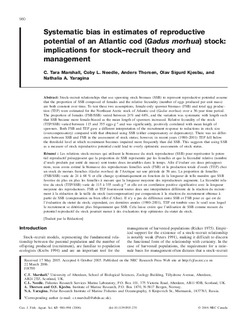| dc.contributor.author | Marshall, C. Tara | |
| dc.contributor.author | Needle, Coby L. | |
| dc.contributor.author | Thorsen, Anders | |
| dc.contributor.author | Kjesbu, Olav Sigurd | |
| dc.contributor.author | Yaragina, Natalia A. | |
| dc.date.accessioned | 2007-06-05T11:13:15Z | |
| dc.date.issued | 2006 | |
| dc.identifier.issn | 0706-652X | |
| dc.identifier.uri | http://hdl.handle.net/11250/108508 | |
| dc.description.abstract | Stock–recruit relationships that use spawning stock biomass (SSB) to represent reproductive potential assume
that the proportion of SSB composed of females and the relative fecundity (number of eggs produced per unit mass)
are both constant over time. To test these two assumptions, female-only spawner biomass (FSB) and total egg production
(TEP) were estimated for the Northeast Arctic stock of Atlantic cod (Gadus morhua) over a 56-year time period.
The proportion of females (FSB/SSB) varied between 24% and 68%, and the variation was systematic with length such
that SSB became more female-biased as the mean length of spawners increased. Relative fecundity of the stock
(TEP/SSB) varied between 115 and 355 eggs·g–1 and was significantly, positively correlated with mean length of
spawners. Both FSB and TEP gave a different interpretation of the recruitment response to reductions in stock size
(overcompensatory) compared with that obtained using SSB (either compensatory or depensatory). There was no difference
between SSB and FSB in the assessment of stock status; however, in recent years (1980–2001) TEP fell below
the threshold level at which recruitment becomes impaired more frequently than did SSB. This suggests that using SSB
as a measure of stock reproductive potential could lead to overly optimistic assessments of stock status. | en |
| dc.format.extent | 892204 bytes | |
| dc.format.mimetype | application/pdf | |
| dc.language.iso | eng | en |
| dc.subject | cod | en |
| dc.subject | fish stocks | en |
| dc.subject | population dynamics | en |
| dc.subject | egg production | en |
| dc.title | Systematic bias in estimates of reproductive potential of an Atlantic cod (Gadus morhua) stock: implications for stock–recruit theory and management | en |
| dc.type | Journal article | en |
| dc.type | Peer reviewed | |
| dc.source.pagenumber | 980-994 | en |
| dc.source.volume | 63 | en |
| dc.source.journal | Canadian Journal of Fisheries and Aquatic Sciences | en |
| dc.source.issue | 5 | |
| dc.identifier.doi | http://dx.doi.org/10.1139/F05-270 | |
